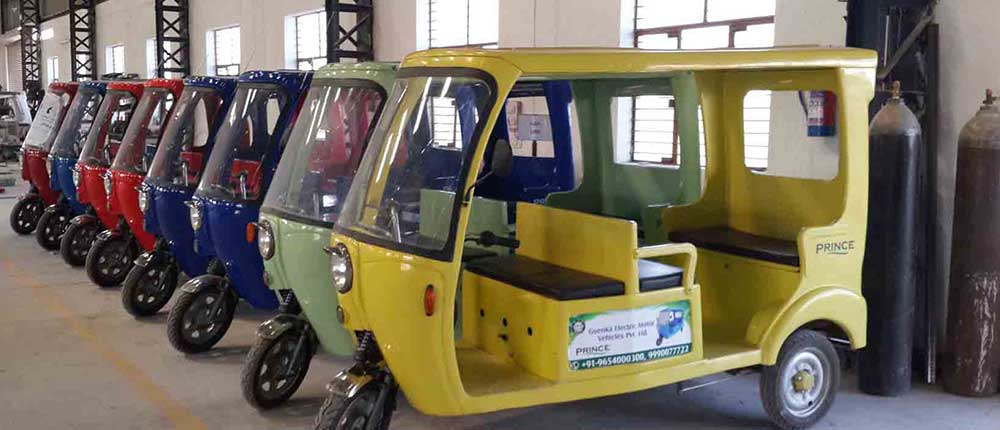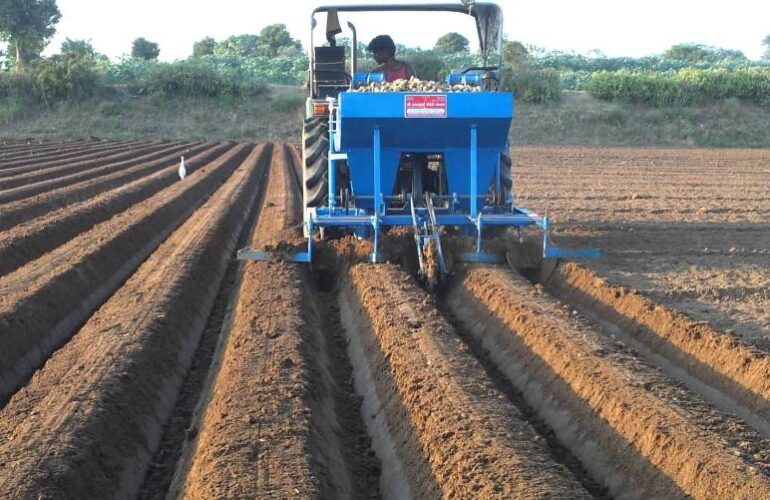Beginning from human-powered cycle rickshaws to auto-rickshaws, era is now drifting towards most recent modification “E-rickshaws”. These battery operated three wheelers are undoubtedly an integral part of transport eco-system in entire Delhi, Lucknow, Varanasi, Ghaziabad, Dehradun, Udaipur, Indore, Patna, Bhagalpur, Ranchi. E-Rickshaws dovetail beautifully as the last mile public conveyance with zero pollution in this entire equation. E-rickshaws approved by the Union Ministry of Road Transport and Highways have a maximum width of 1 metre and maximum length of 2.8 meters and are permitted to carry four passengers. |
As per a report of Centre of Civil Society (CCS), the number of E-rickshaws has risen from 4000 in 2010 to more than 1 Lakh, but a large percentage of such vehicles are still unregistered. There are only 29,123 registered E-rickshaws from April 2013 to March 2017 as per Delhi government records. Urbanization is at its peak in India. The introduction of Metro in the last decade has made commuting easier for longer distances. However, e-rickshaw can provide last mile connectivity and hence buoyed by the success of e-rickshaw service in Noida and Ghaziabad, the Delhi Metro Rail Corporation (DMRC) extended the service to commuters in the national capital. The specially designed E-rickshaws with covered cabin and full front windscreen will provide the last mile connectivity within an area of 3-4 KM around Metro stations. They are also enabled with CCTV and GPS availability. The facility of E-rickshaws at the stations in Gurugram and Faridabad will also get operational very shortly by another operator. On successful implementation of the E-Rickshaw services in the NCR region, services on similar format would be replicated in Delhi subject to the feasibility. |
According to consulting form, A.T. Kearney, around 11,000 new e-rickshaws are sold on a monthly basis in the country. The opportunity is so big that many start-ups are venturing into this space. SmartE, a ride-hailing service that employs over 800 e-rickshaws around New Delhi, believes when looking at electric mobility, the focus should be on whether the government is enabling products that are designed for the future. Ola, India’s largest ride-hailing startups, has plans to employ 10,000 e-rickshaws in its fleet by April 2019. One of the biggest setbacks to the growth of EVs in India is the dearth of charging and battery-swap stations. By the end of 2017, India had just 425 public charging stations. Government and private initiatives are expected to boost this number to 2,800 by 2022, according to BNEF. However, some companies aren’t waiting for the government and are starting to build their own infrastructure. SmartE and Delhi Metro Rail Corp. have struck a deal to provide charging points for e-rickshaws near 10 stations, with plans to cover all 214 stations by the end of 2020. Shishir Agrawal, the managing director of ShiganeVoltz Ltd., the parent company of GreenRick, an e-rick manufacturer, believes that another hurdle in the market is the absence of bank financing for the traditional rickshaw operators, who are typically low-income workers. If this issue is resolved, he believes it could be possible for the Gurgaon-company to produce 1,000 e-ricks a month. He says that the market has the potential for 20 million sales on an annual basis |
InfraInsights sees the segment as the most promising segment in the entire play and which will mushroom at a much faster rate than anticipated by any company. In the report “E-Rickshaw Market Potential in India: Multifold growth anticipated by 2024-25”, aims to provide an objective view on the realistic demand for e-rickshaw over the next 5-6 years and where this demand will emerge from, what all factors will drive growth and what all factor will act as growth deterrent. The report will also outline the opportunity that component manufacturers have for catering to the demand for battery and traction motors. The report will be delivered basis extensive primary research spread across multiple location where e-rickshaw are used and will be used in the times to come. |
- Executive Summary
- Approach & Methodology
- E-Rickshaw Market Landscape in India
- Value Chain
- Growth Trends
- E-rickshaw Economics
- E-Rickshaw Manufacturing Capabilities in India
- OEMs (Organized, Unorganized)
- Component Supplier
- Service requirements
- E-Rickshaw models specification and pricing in India
- Battery Specification
- Charging Times
- Range
- Operating Cost
- Battery Life
- E-Rickshaw Subsidy in India
- E-Rickshaw Capex & Operational Costs
- E-Rickshaw Market in India 2018-19
- By end use application (passenger carrier, load carrier)
- By motor power
- < 1000 W
- 1000-1500 W
- >1500 W
- By battery capacity
- < 101 Ah
- > 101 Ah
- By regions
- North
- East
- West
- South
- By States
- E-Rickshaw Market Growth Drivers
- Rapid urbanization
- Replacement of Cycle Rickshaw with E-Rickshaw
- Subsidy & Finance Support to Buyer
- Cab aggregators like Ola and other moving into E-Rickshaw
- E-Rickshaw Market Growth Restraints
- Charging Infrastructure
- CMVR Rules
- Subsidies & Finance
- Traffic Jam – U.P mulling ban on E-Rickshaw
- E-Rickshaw Ownership
- E-Rickshaw Market in India by 2024-25
- Optimistic Scenario
- Pessimistic Scenario
- Realistic Scenario
- Estimating demand for power by E-Rickshaw for charging
- E-Rickshaw Battery Market in India by 2024-25
- E-Rickshaw Traction Motor Market in India by 2024-25
- E-Rickshaw Exports Opportunity
- Export Trend
- Estimating Exports Volume
- Exports potential across SE Asia, SAARC region, MENA region
- E-Rickshaw Market Need Gap Analysis
- Interview of drivers across select regions across the country
- Competitive Landscape
- Profile of key manufacturers
 We create value for our customers by amalgamating deep functional and energy industry expertise. Our solutions range from in depth research reports to advisory services enabling our customers with energy market insights to take informed decisions, grow and improve on their competitiveness.
Leveraging our breadth of geographical reach we provide solutions in entire energy value chain be it coal, power, oil and gas or renewable. We are a reliable and efficient source comprising of best in class talent pool which provides answer to all the challenges of the energy industry
We create value for our customers by amalgamating deep functional and energy industry expertise. Our solutions range from in depth research reports to advisory services enabling our customers with energy market insights to take informed decisions, grow and improve on their competitiveness.
Leveraging our breadth of geographical reach we provide solutions in entire energy value chain be it coal, power, oil and gas or renewable. We are a reliable and efficient source comprising of best in class talent pool which provides answer to all the challenges of the energy industry



